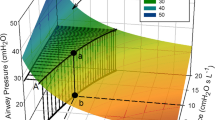Summary
There is a significant high correlation between the form of the pneumotachographic curve and the number, characterizing the resistance of the nose. The resistance of the nose is characterized by the “Widerstandskoeffizient” (Masing). A very important parameter, obscuring the relationship, is the time of easpiration. Diagnostic possibilities are discussed. It is suggested that the pneumotachographic curve, described by Cottle (1968), is of even greater value if used in conjunction with the “Widerstandskoeffizient λ”.
Zusammenfassung
Zwischen der exspiratorischen Form der Pneumotachographiekurve und dem oberen Atemwegswiderstand, ausgedrückt durch den WK λ (Masing), besteht eine signifikante Korrelation. Als Parameter muß jedoch die Exspirationszeit beachtet werden. Diagnostische Möglichkeiten, die sich aus dieser Korrelation in Verbindung mit den von Cottle (1968) angegebenen Atemformen ergeben können, werden diskutiert.
Similar content being viewed by others
Literatur
von Arentsschild, O.: Der Nasenwiderstand bei Eigen- und Fremdstrommessung. Arch. klin. exp. Ohr.-, Nas.- u. Kehlk.-Heilk. 187, 664–669 (1966).
Bachmann, W.: Untersuchungen über Morphologie und Funktion des vorderen Nasenabschnittes. Kritische Analyse der derzeitigen Rhinomanometrie und Vorschlag zu ihrer Standardisierung. Habilitationsschrift; HNO-Klinik der Fakultät für Klinische Medizin, Mannheim, der Ruprecht-Karl-Universität Heidelberg.
Cottle, M. H.: Rhino-sphygmo-manometry and aid in physical diagnosis. Int. Rhinol. 6, 7–26 (1968).
Denning, H.: Lehrbuch der Inneren Medizin, Bd. I, S. 733. Stuttgart: G. Thieme 1950.
Ey, W.: Die Bedeutung der Elektrorhinomanometrie bei der Beurteilung der respiratorischen Leistung der Nase. Vortrag auf der 53. Versammlung der Vereinigung Südwestdeutscher Hals-Nasen-Ohrenärzte in Erlangen v. 26.-28. 9. 1969.
Handbook of Physiologie: Section 3: Respiration (Volume I). Amer. Physiol. Soc., Washington 1964.
Kober, K.: Zur Diagnostik der Nasenallergie. Z. Laryng. Rhinol. 51, 305–309 (1972).
Masing, H.: Die Rhinomanometrie. Elektromedica 2, 6–10 (1967).
Reichel, G., Ulmer, W. T.: Die Atemregulation bei experimenteller Bronchialstenose. Med. thorac. 24, 284–296 (1967).
Ulmer, W. T., Reichel, G., Ey, W.: Der Verlauf herzsynchroner Volumenänderun-gen des Thoraxraumes und deren Auswirkung auf die Ventilation. Pflügers Arch. ges. Physiol. 274, 401–412 (1962).
Author information
Authors and Affiliations
Rights and permissions
About this article
Cite this article
Enzmann, H. Die beziehung des oberen atemwegswiderstandskoeffizienten (WKλ) zur atemform (Pneumotachographiekurve). Arch. Klin. Exp. Ohr.-, Nas.- U. Kehlk. Heilk. 204, 131–142 (1973). https://doi.org/10.1007/BF00302161
Received:
Issue Date:
DOI: https://doi.org/10.1007/BF00302161




